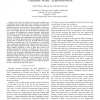Free Online Productivity Tools
i2Speak
i2Symbol
i2OCR
iTex2Img
iWeb2Print
iWeb2Shot
i2Type
iPdf2Split
iPdf2Merge
i2Bopomofo
i2Arabic
i2Style
i2Image
i2PDF
iLatex2Rtf
Sci2ools
ICC
2007
IEEE
2007
IEEE
Time Sharing Policy in Wireless Networks for Variable Rate Transmission
— For most of wireless services with variable rate transmission, both average rate and rate oscillation are important performance metrics. One often needs to decide how much rate oscillation the service can tolerate to obtain a higher average rate. Service satisfaction for each user is quantified by an increasing and concave utility function of instantaneous transmission rate. It is capable of facilitating the resource allocation with flexible combinations of average rate and rate oscillation. Particularly, we are interested in maximizing the time-average aggregate utility by scheduling user transmissions in a time-shared wireless network. A resource allocation policy is developed, namely, time sharing (TS), to exploit the concavity of utility function and the fluctuation of channel gain. This is formulated as a constrained convex optimization problem. Our analysis shows that in the TS policy the optimal scheduler allows multiple users with relatively better channel conditions to ...
| Added | 02 Jun 2010 |
| Updated | 02 Jun 2010 |
| Type | Conference |
| Year | 2007 |
| Where | ICC |
| Authors | Xiaolu Zhang, Meixia Tao, Chun Sum Ng |
Comments (0)

